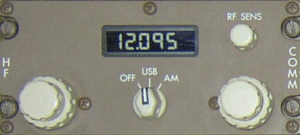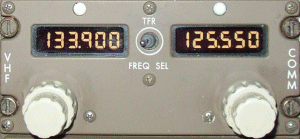Communications - Radios
- Boeing - Stuck Microphone Transmit Switch
Radio Communication System
The Radio Communication System consist of:
HF Communication System
 Two independent HF radios are installed. These are designated HF L (left) and - as installed - HF R (right). The ACPs are used to control voice transmission and receiver monitoring.
Two independent HF radios are installed. These are designated HF L (left) and - as installed - HF R (right). The ACPs are used to control voice transmission and receiver monitoring.
The HF radio(s) are tuned on a dedicated control panel.
To tune the HF radio, rotate the frequency selectors on the control panel. The left knob changes the digits to the left of the decimal point, and the right knob changes the digits to the right of the decimal point.
The HF radio sensitivity can be adjusted by rotating the RF SENS control knob. Rotating clockwise increases the sensitivity to receive weak or distant stations. Rotating counter-clockwise decreases sensitivity to decrease noise and static.
Note: Decreasing sensitivity too far prevents reception, including SELCAL monitoring of the HF radio.
Both HF radios use a common antenna. When either HF radio is transmitting, the antenna is disconnected from the other HF radio, and it cannot be used to transmit or receive. Thus, both radios can be tuned to the same frequency without interfering with each other. However, both HF radios can receive simultaneously if neither is being used for transmitting.
When an HF transmitter is keyed after a frequency change, the Antenna Coupler tunes. While the antenna is being tuned, a 1000 Hz coupler tone an be heard through the audio system (tuning takes a maximum of 15 seconds).
VHF Communication System
 Three independent VHF radios are installed, designated VHF L (left), VHF C (centre) and VHF R (right). The ACPs are used to control voice transmission and receiver monitoring.
Three independent VHF radios are installed, designated VHF L (left), VHF C (centre) and VHF R (right). The ACPs are used to control voice transmission and receiver monitoring.
Each VHF radio allows the tuning of two independent frequencies, an active and a standby frequency. These can be interchanged with the Frequency Transfer Switch.
As installed
ACARS operates through the C-VHF and is automatically tuned to a frequency MHz for data link. ACARS frequency selections can be made through the CDUs or through the C-VHF panel.